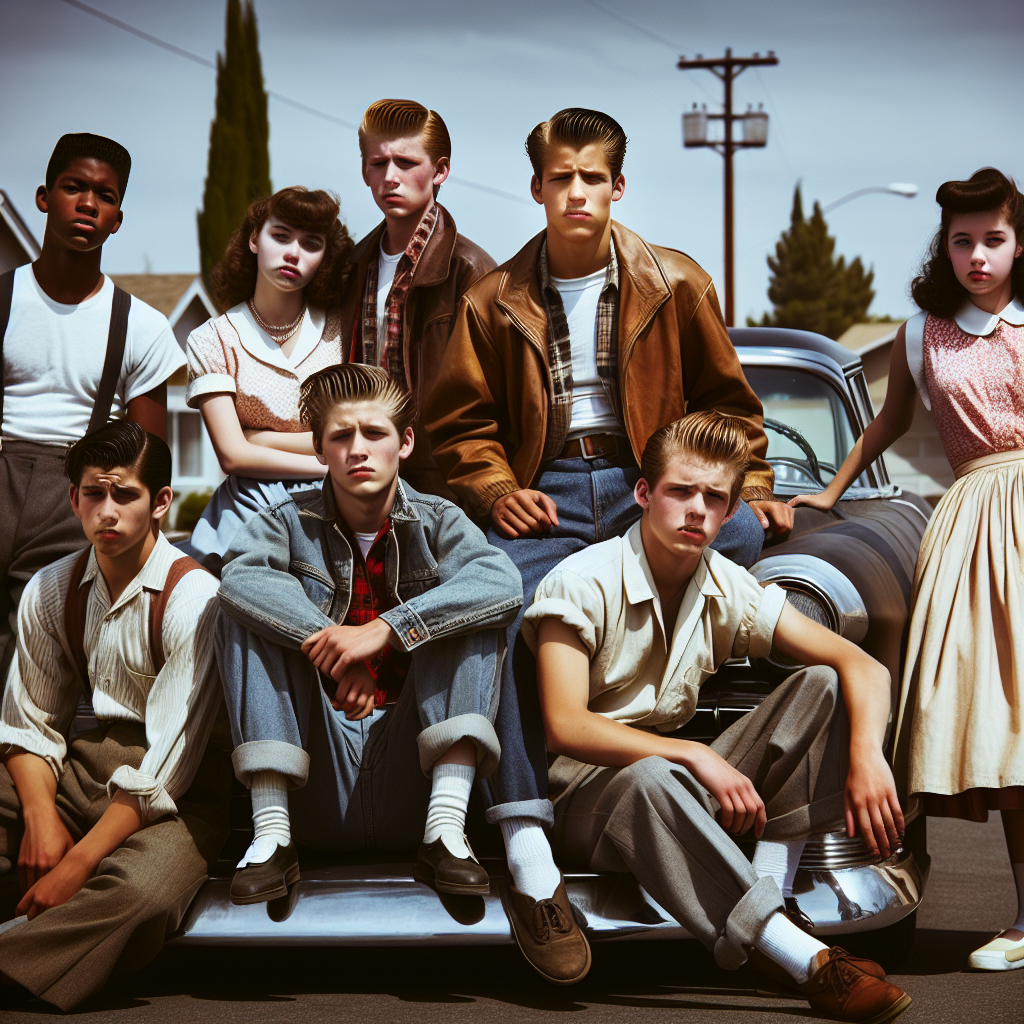Title: Unpacking the Legacy of Rebel Without a Cause (1955): A Timeless Tale of Teenage Rebellion
Introduction
In the annals of cinema history, few films have captured the zeitgeist of adolescence with the intensity and sensitivity as Nicholas Ray’s Rebel Without a Cause (1955). Starring the indelible James Dean, Natalie Wood, and Sal Mineo, the film stands as a cultural touchstone that encapsulates the turbulent essence of teenage rebellion during the mid-20th century. Released during a time when America was grappling with post-war prosperity and burgeoning youth culture, Rebel Without a Cause not only shaped the archetype of the troubled teenager but also marked a significant shift in Hollywood’s portrayal of youth. Its enduring significance is highlighted by its aesthetic innovations, profound thematic explorations, and its legacy in both film and broader cultural narratives.
Main Themes
Central to Rebel Without a Cause is the exploration of existential angst and the yearning for identity and belonging, themes that resonate universally across generations. The film delves into the complexities of familial relationships and societal expectations, portraying a youth disillusioned by the superficiality and hypocrisy of adult authority. James Dean’s character, Jim Stark, becomes the embodiment of this struggle, encapsulating the emotional tribulation of a generation seeking authentic connection in an alienating world.
The theme of defiance against established norms is poignantly illustrated through Jim’s interactions within his family, particularly with his father, Frank Stark, played by Jim Backus. The film explores the erosion of traditional paternal authority, with Frank depicted as weak and indecisive, contrasting sharply against Jim’s desperate need for guidance and strength. This broken father-son dynamic serves as a microcosm of wider societal changes, highlighting the teenage search for role models amid shifting familial structures.
Cinematic Techniques
Nicholas Ray’s distinctive directorial style is central to the film’s impact, utilizing innovative cinematic techniques that heighten the emotional depth and narrative tension. The use of color, particularly the symbolic representation of red, underscores the film’s emotional fervor and internal conflicts. From Jim’s striking red jacket to the kaleidoscopic hues of the Griffith Observatory scenes, color is strategically employed to evoke mood and draw viewers into the psyche of the characters.
The film’s cinematography, helmed by Ernest Haller, exploits dynamic composition and framing to amplify the drama of the story. The iconic ‘chickie run’ sequence, with its dramatic wide shots and close-ups, not only serves as a visual metaphor for the reckless bravado and vulnerability of youth but also showcases Ray’s ability to convey tension and anxiety with visceral intensity. These techniques, along with Leonard Rosenman’s evocative score, contribute to the film’s immersive atmosphere and its capacity to resonate viscerally with audiences.
Character Arcs
The character arcs in Rebel Without a Cause are richly layered, offering deep insights into the complexities of adolescent identity formation. Jim Stark, portrayed by Dean with haunting intensity, transitions from a disaffected newcomer to a character who seeks redemption through finding his place within an ad-hoc family consisting of Judy (Natalie Wood) and Plato (Sal Mineo).
Judy, initially part of the peer group that ostracizes Jim, evolves from a figure seeking superficial acceptance to one who recognizes the profound need for genuine connection. Her relationship with Jim represents a quest for emotional truth, transcending their initial roles as societal pariahs.
Sal Mineo’s Plato, a tragic figure craving affection and acceptance, reflects the profound loneliness that can accompany the teenage experience. His arc is particularly poignant, as his search for belonging ultimately culminates in tragedy, underscoring the high stakes of these formative years.
Cultural, Social, and Historical Contexts
The release of Rebel Without a Cause coincided with a period of significant social upheaval in the United States. The rise of rock ‘n’ roll, the civil rights movement, and increasing questioning of authority structures provided a backdrop for the film’s themes of rebellion and identity. The film’s portrayal of troubled youth resonated deeply with an audience that saw themselves in its characters’ struggles and aspirations.
In the broader cultural context, the film challenged the idealized image of the American family, reflecting the growing disillusionment with traditional societal norms. Its honest depiction of juvenile delinquency raised questions about the systemic failures in addressing youth concerns, sparking dialogue around the role of family and society in nurturing or stifling potential.
Legacy and Influence
Rebel Without a Cause has left an indelible mark on the film industry and popular culture. James Dean’s performance cemented his status as an icon of youthful angst, influencing generations of actors and filmmakers. The film’s themes of rebellion and identity continue to echo in countless films exploring adolescent experiences, from The Breakfast Club to Perks of Being a Wallflower.
Moreover, its impact extends beyond cinema into fashion, music, and youth culture at large, with Dean’s image and the film’s motifs often invoked in discussions of 1950s Americana and its enduring legacies.
Conclusion
Reflecting on Rebel Without a Cause, one is prompted to consider the film’s continued relevance in an ever-evolving society. Are the challenges faced by teenagers today fundamentally different from those portrayed in the film, or have they simply taken on new forms? In what ways do contemporary media portray the complexities of youth identity, and where might there be room for growth?
Ultimately, Rebel Without a Cause remains a timeless exploration of youth and rebellion, offering a lens through which to consider both past and present struggles for identity and understanding. Its legacy endures not only as a cinematic masterpiece but also as a cultural artifact that invites reflection on the perennial quest for belonging and authenticity in an often disorienting world.
Got more questions? Our personalized Movies Explorer AI assistant is here to help. Click here to start a conversation!
[Advertisement]
Looking for deeper meaning in your favorite movies? Discover how ANY movie relates to positive biblical principles with Movies and Scripture GPT from BGodInspired.com. Click here to explore insights you might not have realized! . Simply key in any movie and let it show you insights you might not have realized otherwise!
[Advertisement]

